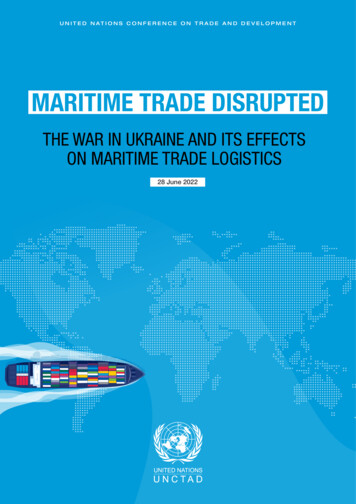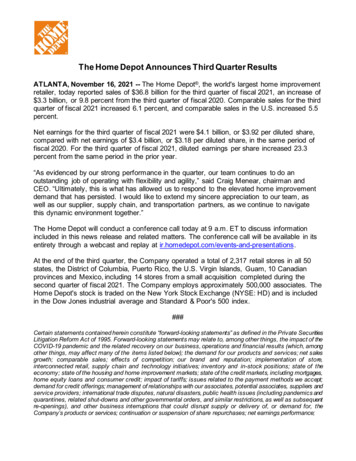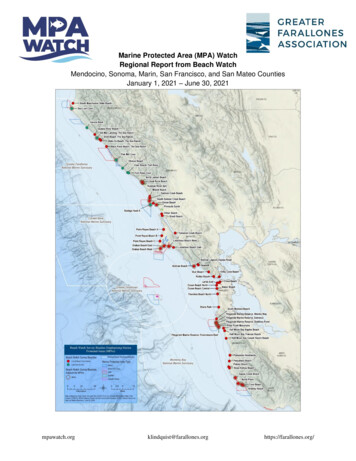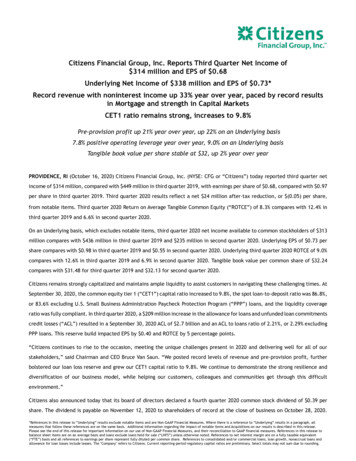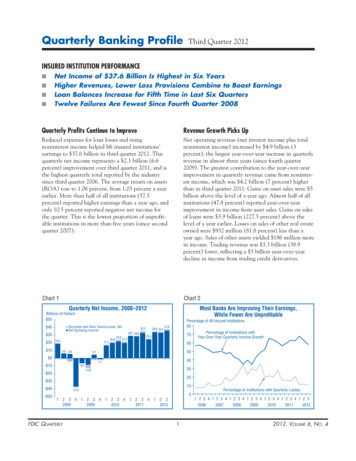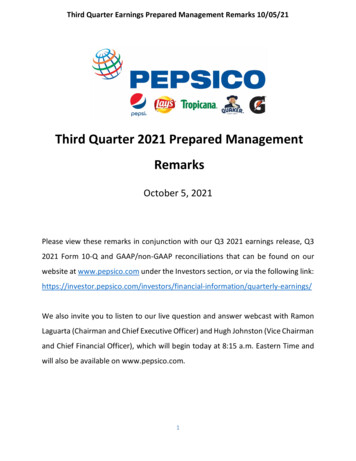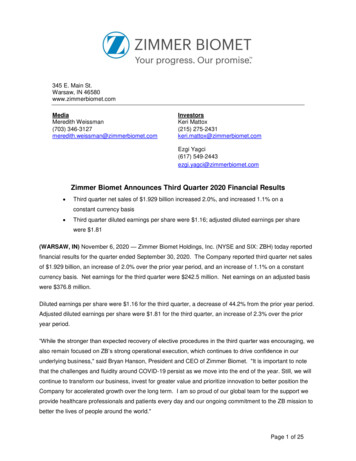
Transcription
[jw]H-DiploJOURNAL WATCH, J to ZH-Diplo Journal and Periodical Reviewwww.h-net.org/ diplo/journals/Third Quarter 201012 July 2010Compiled by Lubna Qureshi, Independent ScholarThe Journal of African History, Vol. 51, Issue 1 (March ssue?jid AFH&volumeld 51&issueld 01&iid 7780656 Priyal Lal, “Militants, Mothers, and the National Family: Ujamaa, Gender, and RuralDevelopment in Postcolonial Tanzania,” 1.Joel Cabrita, “Politics and Preaching: Chiefly Converts to the Nazaretha Church,Obedient Subjects, and Sermon Performance in South Africa,” 21.Douglas Anthony, “’Resourceful and Progressive Blackmen’: Modernity and Race inBiafra, 1967-70,” 41.Egodi Uchendu, “Being Igbo and Muslim: The Igbo of South-Eastern Nigeria andConversions to Islam, 1930s to Recent Times,” 63.Chouki El Hamel, “The Register of the Slaves of Sultan Mawlay Isma’il of Morocco atthe Turn of the Eighteenth Century,” 89.Journal of American-East Asian Relations, Vol. 16, No. 4 (Winter .html Charles W. Hayford, “Framing China: An Introduction.”Copyright 2010 H-Net: Humanities and Social Sciences Online.H-Net permits the redistribution and reprinting of this work for non-profit, educationalpurposes, with full and accurate attribution to the author(s), web location, date of publication,H-Diplo, and H-Net: Humanities & Social Sciences Online. For other uses, contact the H-Diploeditorial staff at h-diplo@h-net.msu.edu.
H-Diplo Journal Watch [jw], A-I, Third Quarter 2010 Shuhua Fan, “To Educate China in the Humanities and Produce China Knowledge inthe United States: The Founding of the Harvard-Yenching Institute, 1924-1928.”Charles W. Hayford, “China by the Book: China Hands and China Stories 1848-1949.”Sigrid Schmalzer, “Speaking about China, Learning from China: Amateur ChinaExperts in 1970s America.”The Journal of American History, Vol. 97, No. 1 (June s/971 Timothy S. Huebner, “Roger B. Taney and the Slavery Issue: Looking beyond - andbefore – Dred Scott,” 17.Terri L. Snyder, “Suicide, Slavery, and Memory in North America,” 39.Thomas A. Guglielmo, “’Red Cross, Double Cross’: Race and America’s World War II–Era Blood Donor Service,” 63.Bernhard Rieger, “From People’s Car to New Beetle: The Transatlantic Journeys ofthe Volkswagen Beetle,” 91.Stephen Kercher, “Pullman Porters: From Service to Civil Rights,” 117.Tammy Gordon, “Olde Mill House Gallery and Printing Museum,” 120.Steve Boyd-Smith, “The Psychedelic Experience: Rock Posters from the SanFrancisco Bay Area, 1965-1971,” 123.Daniel Spock, “The Museum at Bethel Woods Center for the Arts: The Story of theSixties and Woodstock,” 127.Mark Howard Long, “Tampa Bay History Center,” 131.Patrick Ettinger, “United States Immigration Station, Angel Island DetentionBarracks,” 135.Journal of American Studies, Vol. 43, Issue 1 (April ssue?jid AMS&decade 2000&volumeId 43&issueId 01&iid 55025802 Page
H-Diplo Journal Watch [jw], A-I, Third Quarter 2010 Laura Lomas, “José Marti’s ‘Evening of Emerson’ and the United Statesian LiteraryTradition,” 1.M.J. Heale, “Anatomy of a Scare: Yellow Peril Politics in America, 1980-1993,” 19.Will Norman, “Nabokov’s Dystopia: Bend Sinister, America and Mass Culture,” 49.Padraig Kirwan, “Language and Signs: An Interview with Ojibwe Novelist DavidTreuer,” 71.Sarah Martin, “Reading the Historical Novel: Reworking the Past and the Relation ofBlackfeet History in James Welch’s Fools Crow,” 89.Philip H. Christensen, “McGuffey’s Oxford (Ohio) Shakespeare,” 101.Megan E. Williams, “’Meet the Real Lena Horne’: Representations of Lena Horne inEbony Magazine, 1945-1949,” 117.James Annesley, “David Foster Wallace,” 131.Journal of American Studies, Vol. 43, Issue 2 (August ssue?jid AMS&decade 2000&volumeId 43&issueId 02&iid 6001692 Simon P. Newman, “Benjamin Franklin and the Leather-Apron Men: The Politics ofClass in Eighteenth-Century Philadelphia,” 161.Mel Van Elteren, “Neoliberalization and Transnational Capitalism in the AmericanMold,” 177.Glenn Feldman, “Southern Disillusionment with the Democratic Party: CulturalConformity and ‘the Great Melding’ of Racial and Economic Conservatism inAlabama during World War II,” 199.Timothy Randolph Stanley, “’Sailing against the Wind’: A Reappraisal of EdwardKennedy’s Campaign for the 1980 Democratic Party Presidential Nomination,” 231.Sandra Scanlon, “The Conservative Lobby and Nixon’s ‘Peace with Honor’ inVietnam,” 255.Helen Laville, “’Women of Conscience’ or ‘Women of Conviction’? The NationalWomen’s Committee on Civil Rights,” 277.Monica B. Pearl, “’Sweet Home’: Audre Lorde’s Zami and the legacies of AmericanWriting,” 297.3 Page
H-Diplo Journal Watch [jw], A-I, Third Quarter 2010 Mary Unger, “’Dens of Iniquity and Holes of Wickedness’: George Lippard and theQueer City,” 319.Max Paul Friedman, “Simulacrobama: The Mediated Election of 2008,” 341.Journal of American Studies, Vol. 43, Issue 3 (December ssue?jid AMS&decade 2000&volumeId 43&issueId 03&iid 7025044 Sarah Gleeson-White, “William Faulkner’s Go Down, Moses: An American FrontierNarrative,” 389.Nicky Cashman, “Politics, Passion, Prejudice: Alice Childress’s Wedding Band: ALove/Hate Story in Black and White,” 407.James Peacock, “Jonathan Lethem’s Genre Evolutions,” 425.Rocío G. Davis, “Academic Autobiography and Transdisciplinary Crossings in ShirleyGeok-lin Lim’s Among the White Moon Faces,” 441.Peter Swirski, “Literature as History: The Lives and Deaths of Richard MilhousSlurrie and Walter Bodmore Nixon,” 459.Lee Spinks, “Oppen’s Pragmatism,” 477.Brian Ireland, “Errand into the Wilderness: The Cursed Earth as Apocalyptic RoadNarrative,” 497.John Fagg, “Seeing History/Showing Seeing in Ashcan School Painting,” 535.Journal of American Studies, Vol. 44, No. 1 (February ssue?jid AMS&volumeId 44&issueId 01&iid 7289708 Andrew Johnstone, “Americans Disunited: Americans United for World Organizationand the Triumph of Internationalism,” 1.Constance J.S. Chen, “Merchants of Asianness: Japanese Art Dealers in the UnitedStates in the Early Twentieth Century,” 19.Michael Epp, “The Imprint of Affect: Humor, Character and National Identity inAmerican Studies,” 47.Sarah B. Snyder, “’Jerry, Don’t Go’: Domestic Opposition to the 1975 Helsinki FinalAct,” 67.4 Page
H-Diplo Journal Watch [jw], A-I, Third Quarter 2010 Rhodri Jeffreys-Jones, “Changes in the Nomenclature of the American Left,” 83.Barbara Tomlinson, “Transforming the Terms of Reading: Ideologies of Argumentand the ‘Trope of the Angry Feminist’ in Contemporary U.S. Political and AcademicDiscourse,” 101.Graham Cassano, “’The Last of the World’s Afflicted Race of Humans Who Believe inFreedom’: Race, Colonial Whiteness and Imperialism in John Ford and DudleyNichols’s The Hurricane (1937),” 117.Neil Verma, “Honeymoon Shocker: Lucille Fletcher’s ‘Psychological’ Sound Effectsand Wartime Radio Drama,” 137.David Brumble, “Stanley ‘Tookie’ Williams, Gangbanger Autobiography, and WarriorTribes,” 155.Theophilus Savvas, “’Nothing but Words’? Chronicling and Storytelling in RobertCoover’s The Public Burning,” 171.Rachel Carroll, “Retrospective Sex: Rewriting Intersexuality in Jeffrey Eugenides’sMiddlesex,” 187.Maria Ryan, “Intellectuals and the ‘War on Terror,’” 203.Journal of American Studies, Vol. 44, Issue 2 (May ssue?jid AMS&volumeId 44&issueId 02&iid 7586092 Bruce Pilbeam, “The Tragedy of Compassionate Conservatism,” 251.Sandra Wilson Smith, “Frontier Androgyny: An Archetypal Female Hero in TheAdventures of Daniel Boone,” 269James S. Miller, “Zoning the Past: Brokers, Babbitts, and the Memory Work ofCommercial Real Estate,” 287.Martin Halliwell, “Cold War Ground Zero: Medicine, Psyops and the Bomb,” 313.Andrew Pepper, “’Hegemony Protected by the Armour of Coercion’: DashiellHammett’s Red Harvest and the State,” 333.Joe Street, “The Historiography of the Black Panther Party,” 351.Oliver Belas, “Chester Himes’s The End of the Primitive: Exile, Exhaustion,Dissolution,” 377.5 Page
H-Diplo Journal Watch [jw], A-I, Third Quarter 2010 James Russell, “Evangelical Audiences and ‘Hollywood’ Film: Promoting Fireproof(2008),” 391.Subarno Chattarji, “’The New Americans’: The Creation of a Typology of VietnameseAmerican Identity in Children’s Literature,” 409.Devin O. Pendas, “Interrogating Torture: Human Rights, the War on Terror, and theFate of America,” 429.The Journal of Asian Studies, Vol. 69, Issue 1 (February ssue?jid JAS&volumeld 69&issueId 01 “Editorial,” 1.Ellis S. Krauss and Robert J. Pekkanen, “The Rise and Fall of Japan’s LiberalDemocratic Party,” 5.Megan Sinnott, “Borders, Diaspora, and Regional Connections: Trends in Asian‘Queer’ Studies,” 17.Mary Alice Haddad, “From Undemocratic to Democratic Civil Society: Japan’sVolunteer Fire Departments,” 33.Eddy U, “Third Sister Liu and the Making of the Intellectual in Socialist China,” 57.Nimrod Baranovitch, “Others No More: The Changing Representation of Non-HanPeoples in Chinese History Textbooks, 1951-2003,” 85.Lisa Balabanlilar, “The Begims of the Mystic Feast: Turco-Mongol Tradition in theMughal Harem,” 123.Rachel M. McCleary and Leonard W.J. van der Kuijp, “The Market Approach to theRise of the Geluk School, 1419-1642,” 149.Leigh K. Jenco, “’Rule by Man’ and ‘Rule by Law’ in Early Republican China:Contributions to a Theoretical Debate,” 181.Journal of Cold War Studies, Vol. 12, Issue 2 (Spring 2010)http://www.mitpressjournals.org/toc/jcws/12/2 “Editor’s Note,” 1.6 Page
H-Diplo Journal Watch [jw], A-I, Third Quarter 2010 Grace Ai-Ling Chou, “Cultural Education as Containment of Communism: TheAmbivalent Position of American NGOs in Hong Kong in the 1950s,” 3.James G. Blight and Janet Lang, “When Empathy Failed: Using Critical Oral History toReassess the Collapse of U.S.-Soviet Détente in the Carter-Brezhnev Years,” 29.Mark Garrison, “Commentary on ‘When Empathy Failed,’” 75.Raymond J. Garthoff, “On Empathy and Critical Oral History: A Commentary,” 79.Jack F. Matlock, Jr., “Empathy in International Relations: A Commentary,” 89.Robert A. Pastor, “Missing Each Other: A Comment on ‘When Empathy Failed,’” 92.Thomas W. Simons, Jr., “When Policy Failed: A View from the Middle Distance,” 95.James G. Blight and Janet Lang, “Reply to the Commentaries,” 102.Richard Drake, “Terrorism and the Decline of Italian Communism: Domestic andInternational Dimensions,” 110.Thomas A. Dine, “U.S. Policy and Peacemaking Efforts in the Middle East: HistoricalPerspectives,” 117.Journal of Communist Studies and Transition Politics, Vol. 25, Issue 1 (2009)http://www.informaworld.com/smpp/title db all content g909516252 Ben Fowkes and Bülent Gökay, “Unholy Alliance: Muslims and Communists – AnIntroduction,” 1.Vassilis K. Fouskas, “The Imperial Reification of the Qur’an,” 32.Stephen Schwartz, “’Enverists’ and ‘Titoists’ – Communism and Islam in Albania andKosova, 1941-99: From the Partisan Movement of the Second World War to theKosova Liberation War,” 48.Cerwyn Moore and Paul Tumelty, “Assessing Unholy Alliances in Chechnya: FromCommunism and Nationalism to Islamism and Salafism,” 73.Farzana Shain, “Uneasy Alliances: British Muslims and Socialists since the 1950s,”95.Journal of Communist Studies and Transition Politics, Vol. 25, Issues 2 & 3 (2009)http://www.informaworld.com/smpp/title db all content g9129352117 Page
H-Diplo Journal Watch [jw], A-I, Third Quarter 2010 David Lane and Stephen White, “Preface,” 111.David Lane, “’Coloured Revolution’ as a Political Phenomenon,” 113.Vicken Cheterian, “From Reform and Transition to ‘Coloured Revolutions,’” 136.David J. Galbreath, “Putting the Colour into Revolutions? The OSCE and Civil Societyin the Post-Soviet Region,” 161.Christopher Lamont, “Contested Sovereignty: The International Politics of RegimeChange in the Federal Republic of Yugoslavia,” 181.Donnacha Ó Beacháin, “Roses and Tulips: Dynamics of Regime Change in Georgiaand Kyrgyzstan,” 199.Stephen White and Ian McAllister, “Rethinking the ‘Orange Revolution,’” 227.Abel Polese, “Ukraine 2004: Informal Networks, Transformation of Social Capitaland Coloured Revolutions,” 255.Vlad Mykhnenko, “Class Voting and the Orange Revolution: A Cultural PoliticalEconomy Perspective on Ukraine’s Electoral Geography,” 278.John Heathershaw, “Rethinking the International Diffusion of Coloured Revolutions:The Power of Representation in Kyrgyzstan,” 297.Elena Korosteleva, “Was There a Quiet Revolution? Belarus After the 2006Presidential Election,” 324.Wojciech Ostrowski, “The Legacy of the ‘Coloured Revolutions’: The Case ofKazakhstan,” 347.Jeanne L. Wilson, “Coloured Revolutions: The View from Moscow and Beijing,” 369.Stephen White, “Is There a Pattern?,” 396.Journal of Communist Studies and Transition Politics, Vol. 25, Issue 4 (2009)http://www.informaworld.com/smpp/title db all content g917142024 Tim Haughton, “Driver, Conductor or Fellow Passenger? EU Membership and PartyPolitics in Central and Eastern Europe,” 413.Agnes Batory, “The Dog that Did Not Bark? Assessing the Impact of the EU on PartyPolitics in Hungary,” 427.8 Page
H-Diplo Journal Watch [jw], A-I, Third Quarter 2010 Aleks Szczerbiak and Monika Bil, “When in Doubt, (Re-)Turn to Domestic Politics?The (Non-)Impact of the EU on Party Politics in Poland,” 447.Allan Sikk, “Force Mineure? The Effects of the EU on Party Politics in a Small Country:The Case of Estonia,” 468.Alenka Krasovec and Damjan Lajh, “The European Union: A Joker or Just anOrdinary Playing Card for Slovenian Political Parties?,” 491.Vít Hlousek and Pavel Pseja, “Europeanization of Political Parties and the PartySystem in the Czech Republic,” 513.Tim Haughton and Marek Rybár, “A Tool in the Toolbox: Assessing the Impact of EUMembership on Party Politics in Slovakia,” 540.Stephen Whitefield and Robert Rohrschneider, “The Europeanization of PoliticalParties in Central and Eastern Europe? The Impact of EU Entry on Issue Stances,Salience and Programmatic Coherence,” 564.Journal of Communist Studies and Transition Politics, Vol. 26, Issue 1 (2010)http://www.informaworld.com/smpp/title db all content g919249151 “The JCSTP Prize 2009,” iv.Ovsey Shkaratan and Gordey Yastrebov, “Russian Neo-Etacratic Society and itsStratification: Discovering Real Social Groups,” 1.Elena Chebankova, “Business and Politics in the Russian Regions,” 25.Vladimir Shlapentokh, “Is Putin’s Regime Less Vulnerable than Monarchist Russia in1916 or the Soviet Union in 1990?,” 54.Richard Rose and Martin Bobak, “Stresses and Opportunities of Transformation: TheImpact on Health,” 80.Pamela A. Jordan, “Russia’s Managed Democracy and the Civil G8 in 2006,” 101.Adam Fforde, “Rethinking the Political Economy of Conservative Transition: TheCase of Vietnam,” 126.Journal of Communist Studies and Transition Politics, Vol. 26, Issue 2 (2010)http://www.informaworld.com/smpp/title db all content g922321322 Cameron Ross, “Federalism and Inter-governmental Relations in Russia,” 165.Andreas Heinemann-Grüder, “Ten Yardsticks of Federal Conflict Regulation andtheir Application to Russia,” 188.9 Page
H-Diplo Journal Watch [jw], A-I, Third Quarter 2010 Oksana Oracheva and Alexander Osipov, “Territories of ‘Special Status’ in Russia:The Ethnic Dimension,” 212.J. Paul Goode, “The Fall and Rise of Regionalism?,” 233.Darrell Slider, “How United is United Russia? Regional Sources of Intra-partyConflict,” 257.Nikolay Petrov, “Regional Governors under the Dual Power of Medvedev and Putin,”276.Journal of Conflict Resolution, Vol. 54, No. 2 (April 2010)http://jcr.sagepub.com/content/vol54/issue2/ Todd Sandler, “Terrorism and Policy: Introduction,” 203Patrick T. Brandt and Todd Sandler, “What Do Transnational Terrorists Target? HasIt Changed? Are We Safer?,” 214.Jean-Paul Azam and Véronique Thelen, “Foreign Aid Versus Military Intervention inthe War on Terror,” 237.Walter Enders and Paan Jindapon, “Network Externalities and the Structure ofTerror Networks,” 262.Jonathan S. Feinstein and Edward H. Kaplan, “Analysis of a Strategic TerrorOrganization,” 281.S. Brock Blomberg, Rozlyn C. Engel, and Reid Sawyer, “On the Duration andSustainability of Transnational Terrorist Organizations,” 303.Efraim Benmelech, Claude Berrebi, and Esteban F. Klor, “The Economic Cost ofHarboring Terrorism,” 331.Daniel G. Arce and Todd Sandler, “Terrorist Spectaculars: Backlash Attacks and theFocus of Intelligence,” 354.Journal of Conflict Resolution, Vol. 54, No. 3 (June 2010)http://jcr.sagepub.com/content/vol54/issue3/ Julie Browne and Eric S. Dickson, “’We Don’t Talk to Terrorists’: On the Rhetoric andPractice of Secret Negotiations,” 379.10 P a g e
H-Diplo Journal Watch [jw], A-I, Third Quarter 2010 Karen Brounéus, “The Trauma of Truth Telling: Effects of Witnessing in theRwandan Gacaca Courts on Psychological Health,” 408.Seung-Whan Choi, “Legislative Constraints: A Path to Peace?,” 438.R. Urbatsch, “Isolationism and Domestic Politics,” 471.Idean Salehyan, “The Delegation of War to Rebel Organizations, 493Journal of Contemporary African Studies, Vol. 28, Issue 2 (2010)http://www.informaworld.com/smpp/title db all content g922437059 Sara Meger, “Rape of the Congo: Understanding sexual violence in the conflict in theDemocratic Republic of Congo,” 119.Janine Natalya Clark, “National unity and reconciliation in Rwanda: A flawedapproach?,” 137.Darko Kwabena Opoku, “From a ‘success’ story to a highly indebted poor country:Ghana and neoliberal reforms,” 155.Pedro Amakasu Raposo and David M. Potter, “Chinese and Japanese developmentco-operation: South-South, North-South, or what?,” 177.Henning Melber, “Namibia’s national assembly and presidential elections 2009: Diddemocracy win?,” 203.Wazha G. Morapedi, “Demise or resilience? Customary law and chieftaincy intwenty-first century Botswana,” 215.Journal of Contemporary Asia, Vol. 40, Issue 3 (2010)http://www.informaworld.com/smpp/title db all content g923096738 Benjamin K. Sovacool, “A Critical Evaluation of Nuclear Power and RenewableElectricity in Asia,” 369.Dennis Arnold and Toh Han Shih, “A Fair Model of Globalisation? Labour and GlobalProduction in Cambodia,” 401.Alec Gordon, “Netherlands East Indies: The Large Colonial Surplus of Indonesia,1878-1939,” 425.11 P a g e
H-Diplo Journal Watch [jw], A-I, Third Quarter 2010 Chan Chee Khoon, “Re-inventing the Welfarist State? The Malaysian Health Systemin Transition,” 444.Wing-Chung Ho, Wan-Lung Lee, Chun-Man Chan, Yat-Nam Ng, and Yee-Hung Choy,“Hong Kong’s Elite Structure, Legislature and the Bleak Future of Democracy underChinese Sovereignty,” 466.Sarbeswar Sahoo, “Political Mobilisation, the Poor and Democratisation in Neoliberal India,” 487.Andrew Reynolds, “Electoral Democratisation in Nepal,” 509.Journal of Contemporary China, Vol. 19, Issue 65 (2010)http://www.informaworld.com/smpp/title db all content g921754321 Suisheng Zhao, “The China Model: can it replace the Western model ofmodernization?,” 419Barry Naughton, “China’s Distinctive System: can it be a model for others?,” 437Scott Kennedy, “The Myth of the Beijing Consensus,” 461.Tao Xie and Benjamin I. Page, “Americans and the Rise of China as a World Power,”479.Jie Chen, “Transnational Environmental Movement: impacts on the green civilsociety in China,” 503.Qiang Xin, “Beyond Power Politics: institution-building and Mainland China’sTaiwan policy transition,” 525.Kui Yin Cheung, “Spillover Effects of FDI via Exports on Innovation Performance ofChina’s High-Technology Industries,” 541.Hochul Lee, “Political Institutionalization as Political Development in China,” 559.Xiaoping Wang, “Making a Historical Fable: the narrative strategy of Lust, Cautionand its social repercussions,’ 573.Robert Sutter, “Assessing China’s Rise and U.S. Leadership in Asia – growingmaturity and balance,” 591.Journal of Contemporary European Studies, Vol. 18, Issue 2 (2010)12 P a g e
H-Diplo Journal Watch [jw], A-I, Third Quarter 2010http://www.informaworld.com/smpp/title db all content g923157551 Markus Kip, Cathy Maloney, and Adrienne Novak, “Introduction: Contesting‘Europe,’” 157.William Biebuyck, “European Imaginaries and the Intelligibility of Integration,” 161.Sedef Arat-Koç, “Contesting or Affirming ‘Europe’? European Enlargement,Aspirations for ‘Europeanness’ and New Identities in the Margins of Europe,” 181.Gediminas Lankauskas, “Others, the Nation, and its (Dis)integration in ‘European’Lithuania,” 193.Olivia U. Rutazibwa, “The Problematics of the EU’s Ethical (Self)Image in Africa: TheEU as an ‘Ethical Intervener’ and the 2007 Joint Africa-EU Strategy,” 209.Ana Frank, “Rethinking European Past and Future Legacies,” 229.Cosmin Sebastian Cercel, “European Legal Integration as Phantasmagoria: On JusCommune and Political Theology,” 241.Frédéric Royall, “Opportunities and Perception in Pro-Traveller Mobilisations inIreland (1960-2000),” 253.Journal of Contemporary History, Vol. 45, No. 2 (April 2010)http://jch.sagepub.com/content/vol45/issue2/ Stefan Vogt, “Strange Encounters: Social Democracy and Radical Nationalism inWeimar Germany,” 253.Laura D. Beers, “Punting on the Thames: Electoral Betting in Interwar Britain,” 282.Julia Thorpe, “Austrofascism: Revisiting the ‘Authoritarian State’ 40 Years On,” 315.James Matthews, “’Our Red Soldiers’: The Nationalist Army’s Management of its LeftWing Conscripts in the Spanish Civil War 1936-9,” 344.Raffael Scheck, “The Prisoner of War Question and the Beginnings of Collaboration:The Franco-German Agreement of 16 November 1940,” 364.Stephen Connor, “Side-stepping Geneva: Japanese Troops under British Control,1945-7,” 389.Guy Ziv, “Shimon Peres and the French-Israeli Alliance, 1954-9,” 406.13 P a g e
H-Diplo Journal Watch [jw], A-I, Third Quarter 2010 Hannah Gurman, “’Learn to Write Well’: The China Hands and the Communistification of Diplomatic Reporting,” 430.Gavin Schaffer, “Till Death Us Do Part and the BBC: Racial Politics and the BritishWorking Classes 1965-75,” 454.Arthur Aughey, “Questioning British Identity: Review Article,” 478.The Journal of Economic History, Vol. 69, Issue 1 (March ssue?jid JEH&decade 2000&volumeId 69&issueId 01&iid 3985168 Valerie A. Ramey, “Time Spent in Home Production in the Twentieth-Century UnitedStates: New Estimates from Old Data,” 1.Mark Dincecco, “Fiscal Centralization, Limited Government, and Public Revenues inEurope, 1650-1913,” 48.Lee J. Alston, Shannan Mattiace, and Tomas Nonnenmacher, “Coercion, Culture, andContracts: Labor and Debt on Henequen Haciendas in Yucatán, Mexico, 1870-1915,”104.Kris James Mitchener and Mari Ohnuki, “Institutions, Competition, and CapitalMarket Integration in Japan,” 138.Christiana Stoddard, “Why did Education Become Publicly Funded? Evidence fromthe Nineteenth-Century Growth of Public Primary Schooling in the United States,”172.Dan Bogart, “Nationalizations and the Development of Transport Systems: CrossCountry Evidence from Railroad Networks, 1860-1912,” 202.James I. Stewart, “Economic Opportunity or Hardship? The Causes of GeographicMobility on the Agricultural Frontier, 1860-1880,” 238.Latika Chaudhary, “Determinants of Primary Schooling in British India,” 269.The Journal of Economic History, Vol. 69, Issue 2 (June ssue?jid JEH&decade 2000&volumeId 69&issueId 02&iid 5594008 Alan L. Olmstead, “The First Line of Defense: Inventing the Infrastructure to CombatAnimal Diseases,” 327.14 P a g e
H-Diplo Journal Watch [jw], A-I, Third Quarter 2010 Catalina Vizcarra, “Guano, Credible Commitments, and Sovereign Debt Repayment inNineteenth-Century Peru,” 358.Trevon D. Logan, “The Transformation of Hunger: The Demand for Calories Past andPresent,” 388.Eltjo Buringh and Jan Luiten Van Zanden, “Charting the ‘Rise of the West’:Manuscripts and Printed Books in Europe, A Long-Term Perspective from the Sixththrough Eighteenth Centuries,” 409.Gary Richardson and Patrick Van Horn, “Intensified Regulatory Scrutiny and BankDistress in New York City During the Great Depression,” 446.Alvaro S. Pereira, “The Opportunity of a Disaster: The Economic Impact of the 1755Lisbon Earthquake,” 466.Carsten Burhop and Thorsten Lübbers, “Cartels, Managerial Incentives, andProductive Efficiency in German Coal Mining, 1881-1913,” 500.Bruce W. Hetherington and Peter J. Kower, “A Reexamination of Lebergott’s ParadoxAbout Blockade Running During the American Civil War, 528.The Journal of Economic History, Vol. 69, Issue 3 (September ssue?jid JEH&decade 2000&volumeId 69&issueId 03&iid 6068628 Eric Hilt and Katharine O’Banion, “The Limited Partnership in New York, 18221858: Partnerships Without Kinship,” 615.Marc Flandreau and Juan H. Flores, “Bonds and Brands: Foundations of SovereignDebt Markets, 1820-1830,” 646.Fabian Lange, Alan L. Olmstead, and Paul W. Rhode, “The Impact of the Boll Weevil,1892-1932,” 685.Alexander Moradi, “Towards an Objective Account of Nutrition and Health inColonial Kenya: A Study of Stature in African Army Recruits and Civilians 18801980,” 719.Leah Platt Boustan, “Competition in the Promised Land: Black Migration and RacialWage Convergence in the North, 1940-1970,” 755.Brian A’Hearn, Jörg Baten, and Dorothee Crayen, “Quantifying Quantitative Literacy:Age Heaping and the History of Human Capital,” 783.15 P a g e
H-Diplo Journal Watch [jw], A-I, Third Quarter 2010 Eliana Balla and Noel D. Johnson, “Fiscal Crisis and Institutional Change in theOttoman Empire and France,” 809.Nikolaus Wolf, “Was Germany Ever United? Evidence from Intra- and InternationalTrade, 1855-1933,” 846.The Journal of Economic History, Vol. 69, Issue 4 (December ssue?jid JEH&decade 2000&volumeId 69&issueId 04&iid 6586476 Robert C. Allen, “The Industrial Revolution in Miniature: The Spinning Jenny inBritain, France, and India,” 901.Xavier Tafunell, “Capital Formation in Machinery in Latin America, 1890-1930,” 928.Rui Esteves and David Khoudour-Castéras, “A Fantastic Rain of Gold: EuropeanMigrants’ Remittances and Balance of Payments Adjustment During the GoldStandard Period,” 951.Charles W. Calomiris and Jonathan B. Pritchett, “Preserving Slave Families for Profit:Traders’ Incentives and Pricing in the New Orleans Slave Market,” 986.Markus Lampe, “Effects of Bilateralism and the MFN Clause on International Trade:Evidence for the Cobden-Chevalier Network, 1860-1875,” 1012.Kenneth M. Sylvester, “Ecological Frontiers on the Grasslands of Kansas: Changes inFarm Scale and Crop Diversity,” 1041.Leandro Prados de la Escosura and Joan R. Rosés, “The Sources of Long-Run Growthin Spain, 1850-2000,” 1063.Dror Goldberg, “The Massachusetts Paper Money of 1690,” 1092.Graeme G. Acheson, Charles R. Hickson, John D. Turner, and Qing Ye, “RuleBritannia! British Stock Market Returns, 1825-1870,” 1107.Myung Soo Cha, “Productivity Trend in Korean from the Seventeenth to NineteenthCentury: A Comment on Jun, Lewis, and Kang,” 1138.Jun Seong Ho, James B. Lewis, and Kang Han-Rog, “Stability or Decline? Demand orSupply?,” 1144.The Journal of Economic History, Vol. 70, Issue 1 (March ssue?jid JEH&volumeId 70&issueId 01&iid 728852016 P a g e
H-Diplo Journal Watch [jw], A-I, Third Quarter 2010 Sun Go and Peter Lindert, “The Uneven Rise of American Public Schools to 1850,” 1.Kris James Mitchener, Masato Shizume, and Marc D. Weidenmier, “Why didCountries Adopt the Gold Standard? Lessons from Japan,” 27.Tom Nicholas, “The Role of Independent Invention in U.S. TechnologicalDevelopment, 1880-1930,” 57.Elizabeth Brainerd, “Reassessing the Standard of Living in the Soviet Union: AnAnalysis Using Archival and Anthropometric Data,” 83.Farley Grubb, “Testing for the Economic Impact of the U.S. Constitution: PurchasingPower Parity Across the Colonies versus Across the States, 1748-1811,” 118.Sibylle H. Lehmann, “The German Elections in the 1870s: Why Germany Turnedfrom Liberalism to Protectionism,” 146.Tirthankar Roy, “Economic Conditions in Early Modern Bengal: A Contribution tothe Divergence Debate,” 179.Todd C. Neumann, Price V. Fishback, and Shawn Kantor, “The Dynamics of ReliefSpending and the Private Urban Labor Market During the New Deal,” 195.John R. Bowblis, “The Decline in Infant Death Rates, 1878-1913: The Role of EarlySickness Insurance Programs,” 221.The Journal of Economic History, Vol. 70, Issue 2 (June ssue?jid JEH&volumeId 70&issueId 02&iid 7782277 Richard H. Steckel, “Inequality Amidst Nutritional Abundance: Native Americans onthe Great Plains,” 265.Sheilagh Ogilvie, “Consumption, Social Capital, and the ‘Industrious Revolution’ inEarly Modern Germany,” 287.Alexander J. Field, “The Procyclical Behavior of Total Factor Productivity in theUnited States, 1890-2004,” 326.Tahir Andrabi and Michael Kuehlwein, “Railways and Price Convergence in BritishIndia,” 351.Fabio Sánchez, María del Pilar López-Uribe, and Antonella Fazio, “Land Conflicts,Property Rights, and the Rise of the Export Economy in Colombia, 1850-1925,” 378.17 P a g e
H-Diplo Journal Watch [jw], A-I, Third Quarter 2010 Stephen Broadberry and Carsten Burhop, “Real Wages and Labor Productivity inBritain and Germany, 1871-1938: A Unified Approach to the InternationalComparison of Living Standards,” 400.Neil Canaday and Charles Reback, “Race, Literacy, and Real Estate Transactions inthe Po
Andrew Pepper, "'Hegemony Protected by the Armour of Coercion': Dashiell Hammett's Red Harvest and the State," 333. Joe Street, "The Historiography of the Black Panther Party," 351. Oliver Belas, "Chester Himes's The End of the Primitive: Exile, Exhaustion, Dissolution," 377.

